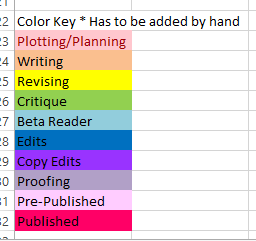I never expected this post to take off like it did the last couple of years. Up until recently there haven’t been many resources for writers to track their writing or editing metrics. These days you can find a variety of options, but at this point my spreadsheets are part of my year.
Since 2013 I’ve shared these out to other authors as a free resource for tracking and reporting. Often times we only have the income earned as a metric to gauge the success of a year, but that’s not really enough. As an example, in 2015 I wrote an entire series for publication in 2016. So while I wrote a metric ton of words, I didn’t make as much. As authors there are different kinds of success, be they career or personal.
 Personally, I’m a metrics girl. To the left you can see a screen shot of my latest numbers for 2016. The year isn’t over yet and I’ve got a book due!
Personally, I’m a metrics girl. To the left you can see a screen shot of my latest numbers for 2016. The year isn’t over yet and I’ve got a book due!
Now, what the heck am I talking about? What do these sheets tell me?
Every year these evolve. From the first incarnation that had only one tab to today’s that’s roughly 14 to twenty tabs and a lot of coding.
I like numbers. I’m not good with them, but I like them. I also like to have a tangible idea of what I’ve accomplished each month. Just looking at the above capture, you can see that from going to a full time writer in February my output has greatly increased.
What I have is an Excel workbook I’ve set up something like a calendar and each day I record how many words and how many pages I edited on a particular project. The above snapshot shows you a yearly summary, but there are also tabs or pages for each month that look something like this:
You can click on the image for a bigger view.
What you’re seeing is the progress I made in October 2016, and how I worked on juggling a few different projects. The sheets are built for ten projects, though I don’t anticipate a person working on all ten for a single month. I usually hide the rows of projects I am not working on, but are still in various stages of being written, revised or edited. From looking at the above snapshot, you can tell that I juggled five different projects that month. It was an abnormally productive month for me, so take that into account.
If you look to the right of the monthly stuff, you can see a grouping of six columns which provide an area to jot down where you start and stop each day.
New for the 2015 version and further improved in 2016 is a new tab to track books progress through the months. It’s called the Year Overview tab. I did this so I can more accurately track how much time it takes me to produce a book. In this time of pushing to produce more, knowing my production times is huge. The 2016 version (not pictured) further breaks down the months into sub-weeks so that there’s a more micro-view of a book’s evolution.

 One catch is that the color coding is not automatic on this sheet. You have to apply it manually. You can select the various categories through a drop down menu. I might add a couple of columns for each month in the instance of when a book goes through multiple phases in the same month. Since this is a new tab, I’m sure it’s going to go through some change until it’s really ready.
One catch is that the color coding is not automatic on this sheet. You have to apply it manually. You can select the various categories through a drop down menu. I might add a couple of columns for each month in the instance of when a book goes through multiple phases in the same month. Since this is a new tab, I’m sure it’s going to go through some change until it’s really ready.
Okay, I’m not 100% sure this was a great explanation. It just occurred to me to post this and links to my template files. Should you like your own versions to tweak, I have two types. The first is a plain-Jane excel workbook, and the second is a prettier one with inspirational quotes from famous writers.
Download the 2017 Workbook (plain)
Download the 2017 Workbook (colorful)
Happy 2017 writing!
![]()


Thank you! That’s so cool.
This is an amazing resource! Thank you so much for posting and sharing.